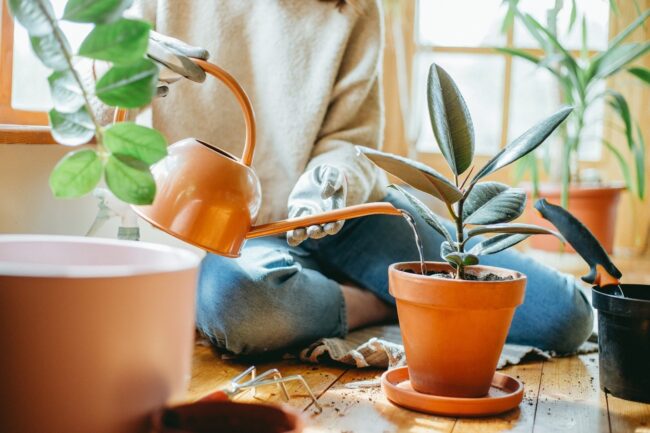Margaret Murphy
Horticulture Educator for Chippewa, Dunn, & Eau Claire Counties
UW-Madison Extension
It is estimated that 66% of all households in the United States decorate their homes with at least one houseplant. This is not surprising since houseplants add beauty and interest to our indoor space as well as provide a boost of green cheer through the long winter months.
There are a few things to think about when it comes to winter care of houseplants such as home temperature, watering and fertilization.
When it comes to temperature, the good news is that most houseplants are fine at temperatures that many of us keep our homes during the winter. The majority of foliage houseplants, for example, manage well with daytime temperatures between 65 to 70 degrees F and nighttime temperatures from 60 to 65 degrees. However, houseplants can be adversely affected by being exposed to temperature extremes. Avoid placing them near heat vents, fireplaces or radiators where they will receive blasts of hot air or too near windows or doors where they may encounter cold drafts.

The moisture needs of a houseplant can be influenced by a number of things including type of plant, type of container, type of soil, time of year and level of relative humidity. If you’re like me, you find it easier to remember to water if you keep to a schedule, but ideally, plants should be watered only when they need it. For most, this is when the top inch or so of soil is dry to the touch. If you are not sure of a specific plant’s watering needs, check a reliable guide to houseplants (or contact your local Extension horticulture educator as we are happy to help). Keep in mind, watering needs for some houseplants may be reduced during the winter.
No matter what the water requirements are for a plant, remember not to let the plant sit directly in water for too long. Allow about 15 to 20 minutes for any excess water to drain into the saucer and for the plant to absorb what it needs. Then discard the excess water in the saucer.
During the winter, it is also a good idea to consider the humidity level in the house. Many houseplants favor a higher relative humidity (40-50 percent) than the average home usually provides at this time of year. Humidifiers are a great way to increase the relative humidity. Grouping plants closely together can also help. Plants release moisture from tiny pores in their leaves through a process called transpiration. This helps increase the humidity level of the air around them.
Another method you can try is to place houseplants on trays filled with small rocks or pebbles. Add water to the trays but make sure the plant roots are not sitting in the water. Evaporation of the water helps increase the relative humidity around the plants.
I sometimes get asked if misting houseplants is a good way to raise the relative humidity. In general, any small gain, even in a small space, is quickly lost unless you are misting regularly throughout the day so not an effective way to raise the relative humidity.
When it comes to fertilizing houseplants, the rule of thumb is fertilize only when houseplants are actively growing. Fertilization is not necessary or should be reduced during the winter months because most plants are growing very little or resting.
Lastly, keep indoor plants well-groomed by removing dead leaves or stems. Larger leafed plants may also need gentle dusting from time to time. Though houseplants can become infected with pests or diseases and should be periodically inspected for such; more commonly problems arise due to improper watering or fertilizing. For more information on general houseplant care, take a look at UW Madison Division of Extension horticulture publication, Houseplant Care, at https://hort.extension.wisc.edu/articles/houseplant-care/. You can also find resources about houseplants on our Wisconsin Horticulture Division of Extension website at https://hort.extension.wisc.edu/article-topic/houseplants/.





